What is System Testing?
System Testing is a level of testing that validates the complete and fully integrated software product. The purpose of a system test is to evaluate the end-to-end system specifications. Usually, the software is only one element of a larger computer-based system. Ultimately, the software is interfaced with other software/hardware systems. System Testing is defined as a series of different tests whose sole purpose is to exercise the full computer-based system.
System Testing is carried out on the whole system in the context of either system requirement specifications or functional requirement specifications or in the context of both. System testing tests the design and behavior of the system and also the expectations of the customer. It is performed to test the system beyond the bounds mentioned in the software requirements specification (SRS). System Testing is basically performed by a testing team that is independent of the development team that helps to test the quality of the system impartial. It has both functional and non-functional testing. System Testing is a black-box testing. System Testing is performed after the integration testing and before the acceptance testing..
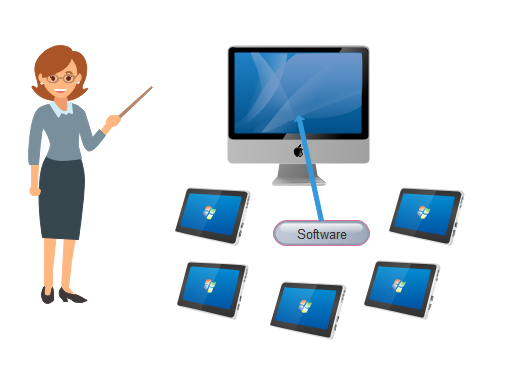

System Testing Process: System Testing is performed in the following steps:
- Test Environment Setup: Create testing environment for the better quality testing.
- Create Test Case: Generate test case for the testing process.
- Create Test Data: Generate the data that is to be tested.
- Execute Test Case: After the generation of the test case and the test data, test cases are executed.
- Defect Reporting: Defects in the system are detected.
- Regression Testing: It is carried out to test the side effects of the testing process.
- Log Defects: Defects are fixed in this step.
- Retest: If the test is not successful then again test is performed.

Types of System Testing:
- Performance Testing: Performance Testing is a type of software testing that is carried out to test the speed, scalability, stability and reliability of the software product or application.
- Load Testing: Load Testing is a type of software Testing which is carried out to determine the behavior of a system or software product under extreme load.
- Stress Testing: Stress Testing is a type of software testing performed to check the robustness of the system under the varying loads.
- Scalability Testing: Scalability Testing is a type of software testing which is carried out to check the performance of a software application or system in terms of its capability to scale up or scale down the number of user request load.
Tools used for System Testing :
- JMeter
- Gallen Framework
- Selenium
Hierarchy of Testing Levels
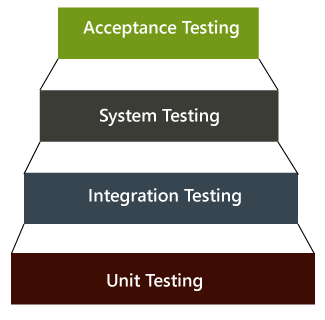
There are mainly two widely used methods for software testing, one is White box testing which uses internal coding to design test cases and another is black box testing which uses GUI or user perspective to develop test cases.
- White box testing
- Black box testing
System testing falls under Black box testing as it includes testing of the external working of the software. Testing follows user's perspective to identify minor defects.
System Testing includes the following steps.
- Verification of input functions of the application to test whether it is producing the expected output or not.
- Testing of integrated software by including external peripherals to check the interaction of various components with each other.
- Testing of the whole system for End to End testing.
- Behavior testing of the application via auser's experience
Example of System testing
Suppose we open an application, let say www.rediff.com, and there we can see that an advertisement is displayed on the top of the homepage, and it remains there for a few seconds before it disappears. These types of Ads are done by the Advertisement Management System (AMS). Now, we will perform system testing for this type of field.
The below application works in the following manner:
- Let's say that Amazon wants to display a promotion ad on January 26 at precisely 10:00 AM on the Rediff's home page for the country India.
- Then, the sales manager logs into the website and creates a request for an advertisement dated for the above day.
- He/she attaches a file that likely an image files or the video file of the AD and applies.
- The next day, the AMS manager of Rediffmail login into the application and verifies the awaiting Ad request.
- The AMS manager will check those Amazons ad requests are pending, and then he/she will check if the space is available for the particular date and time.
- If space is there, then he/she evaluate the cost of putting up the Ad at 15$ per second, and the overall Ad cost for 10 seconds is approximate 150$.
- The AMS manager clicks on the payment request and sends the estimated value along with the request for payment to the Amazon manager.
- Then the amazon manager login into the Ad status and confirms the payment request, and he/she makes the payment as per all the details and clicks on the Submit and Pay
- As soon as Rediff's AMs manager gets the amount, he/she will set up the Advertisement for the specific date and time on the Rediffmail's home page.
The various system test scenarios are as follows:
Scenario1: The first test is the general scenario, as we discussed above. The test engineer will do the system testing for the underlying situation where the Amazon manager creates a request for the Ad and that Ad is used at a particular date and time.
Scenario2: Suppose the Amazon manager feels that the AD space is too expensive and cancels the request. At the same time, the Flipkart requests the Ad space on January 26 at 10:00 AM. Then the request of Amazon has been canceled. Therefore, Flipkart's promotion ad must be arranged on January 26 at 10 AM.
After all, the request and payment have been made. Now, if Amazon changes their mind and they feel that they are ready to make payment for January 26 at 10 AM, which should be given because Flipkart has already used that space. Hence, another calendar must open up for Amazon to make their booking.
Scenario3: in this, first, we login as AMS manger, then click on Set Price page and set the price for AD space on logout page to 10$ per second.
Then login as Amazon manager and select the date and time to put up and Ad on the logout page. And the payment should be 100$ for 10 seconds of an Ad on Rediffmail logout page.
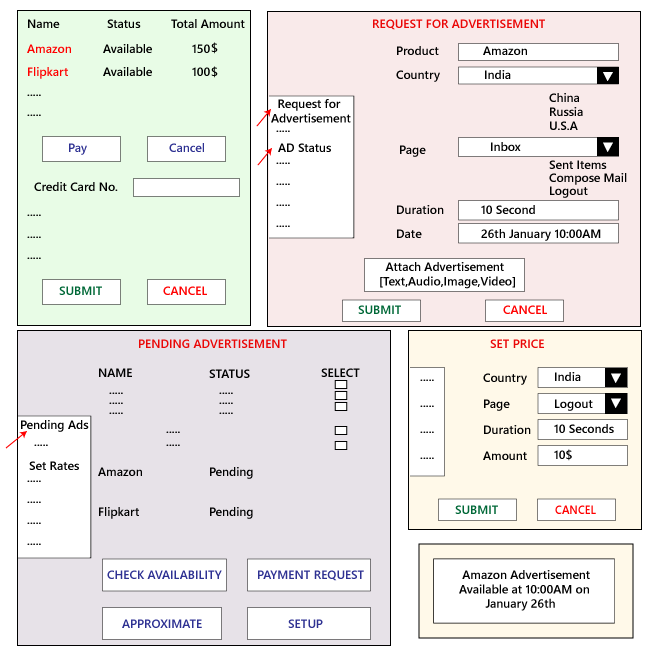
As we can see in the below image, we have three different modules like Loans, Sales, and Overdraft. And these modules are going to be tested by their assigned test engineers only because if data flow between these modules or scenarios, then we need to clear that in which module it is going and that test engineer should check that thing.
Let us assume that here we are performing system testing on the interest estimation, where the customer takes the Overdraft for the first time as well as for the second time.
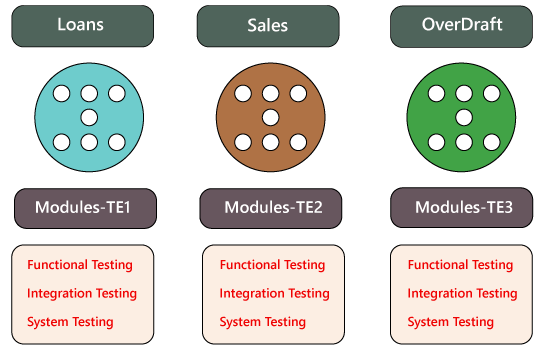
In this particular example, we have the following scenarios:
Scenarios 1
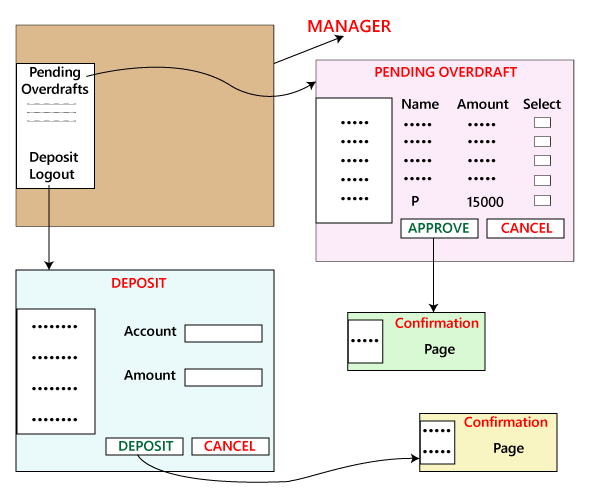
- First, we will log in as a User; let see P, and apply for Overdraft Rs15000, click on apply, and logout.
- After that, we will log in as a Manager and approve the Overdraft of P, and logout.
- Again we will log in as a P and check the Overdraft balance; Rs15000 should be deposited and logout.
- Modify the server date to the next 30 days.
- Login as P, check the Overdraft balance is 15000+ 300+200=15500, than logout
- Login as a Manager, click on the Deposit, and Deposit Rs500, logout.
- Login as P, Repay the Overdraft amount, and check the Overdraft balance, which is Rs zero.
- Apply for Overdraft in Advance as a two-month salary.
- Approve by the Manager, amount credit and the interest will be there to the processing fee for 1st time.
- Login user → Homepage [Loan, Sales, Overdraft] → Overdraft page [Amount Overdraft, Apply Overdraft, Repay Overdraft] →Application
- Login manager → Homepage [Loan, Sales, Overdraft] → Overdraft page [Amount Overdraft, Apply Overdraft, Repay Overdraft, Approve Overdraft]→ Approve Page →Approve application.
- Login as user P → Homepage [Loan, Sales, Overdraft] → Overdraft page [Amount Overdraft, Apply Overdraft, Repay Overdraft] →Approved Overdraft →Amount Overdraft
- Login as user P→Homepage [Loan, Sales, Overdraft] → Overdraft page [Amount Overdraft, Apply Overdraft, Repay Overdraft] →Repay Overdraft → with process fee + interest amount.
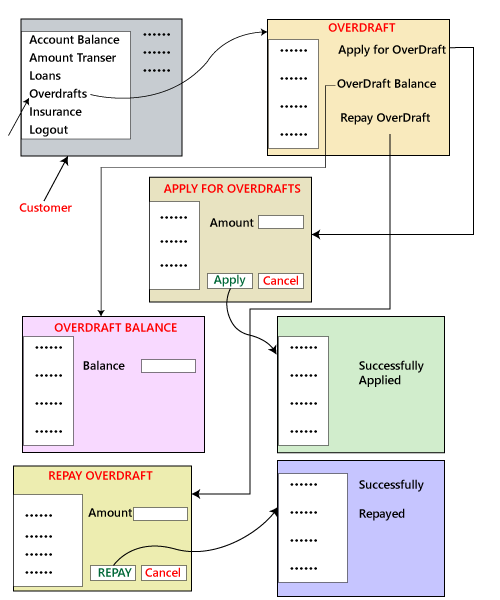
Scenario 2
we test the alternative scenario where the bank provides an offer, which says that a customer who takes Rs45000 as Overdraft for the first time will not charge for the Process fee. The processing fee will not be refunded when the customer chooses another overdraft for the third time.
We have to test for the third scenario, where the customer takes the Overdraft of Rs45000 for the first time, and also verify that the Overdraft repays balance after applying for another overdraft for the third time.
Scenario 3
In this, we will reflect that the application is being used generally by all the clients, all of a sudden the bank decided to reduce the processing fee to Rs100 for new customer, and we have test Overdraft for new clients and check whether it is accepting only for Rs100.
But then we get conflicts in the requirement, assume the client has applied for Rs15000 as Overdraft with the current process fee for Rs200. Before the Manager is yet to approve it, the bank decreases the process fee to Rs100.
Now, we have to test what process fee is charged for the Overdraft for the pending customer. And the testing team cannot assume anything; they need to communicate with the Business Analyst or the Client and find out what they want in those cases.
Therefore, if the customers provide the first set of requirements, we must come up with the maximum possible scenarios.
Advantages of System Testing :
- The testers do not require more knowledge of programming to carry out this testing.
- It will test the entire product or software so that we will easily detect the errors or defects which cannot be identified during the unit testing and integration testing.
- The testing environment is similar to that of the real time production or business environment.
- It checks the entire functionality of the system with different test scripts and also it covers the technical and business requirements of clients.
- After this testing, the product will almost cover all the possible bugs or errors and hence the development team will confidently go ahead with acceptance testing.
Disadvantages of System Testing :
- This testing is time consuming process than another testing techniques since it checks the entire product or software.
- The cost for the testing will be high since it covers the testing of entire software.
- It needs good debugging tool otherwise the hidden errors will not be found.